Excelsior
Vulcans
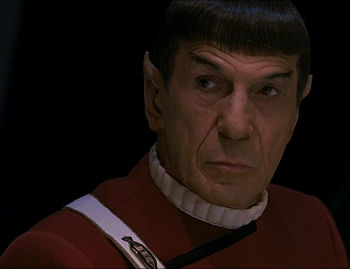
Spock, Vulcan male (ST-06)
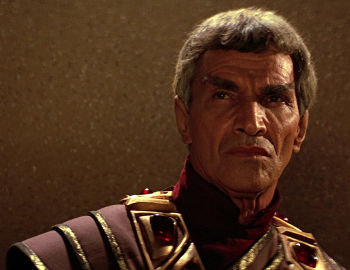
Sarek, Vulcan male (ST-03)

T’Pol, Vulcan female (ENT-22)
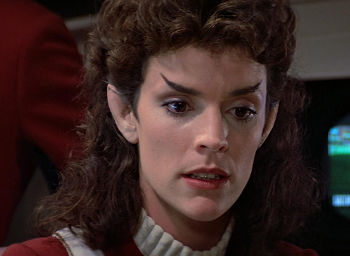
Saavik, Vulcan female (ST-03)
Species originating on Vulcan,[3] Vulcans were dedicated to a philosophy of emotional suppression in favor of total logic.[2]
References
- 1. “The Cage.” Star Trek, Episode 00. Television. 1965 (Unaired).
- 2. “Mudd’s Women.” Star Trek, Episode 03. Television. 13 October 1966.
- 3. “Amok Time.” Star Trek, Episode 34. Television. 15 September 1967.
- 4. “Journey to Babel.” Star Trek, Episode 44. Television. 17 November 1967.
- 5. “The Savage Curtain.” Star Trek, Episode 77. Television. 7 March 1969.
- 6. Star Trek II: The Wrath of Khan. Film. 4 June 1982.
- 7. “Broken Bow.” Star Trek: Enterprise, Episodes 01-02. Television. 26 September 2001.
Starfleet Command

Starfleet Command (ST-04)
The operating authority for Starfleet,[1] Starfleet Command was based out of San Francisco on Earth,[2] though command facilities were also located on major worlds and starbases throughout Federation space.[3] The Chief of Starfleet Operations oversaw a staff of admirals, each responsible for a specific region or division.[4]
References
- 1. “Court Martial.” Star Trek, Episode 15. Television. 2 February 1967.
- 2. Star Trek IV: The Voyage Home. Film. 26 November 1986.
- 3. The Star Trek Encyclopedia. Book. 1997 (rev. ed.). Pocket Books.
- 4. “Core Game Book.” Star Trek: The Next Generation Role Playing Game, Book 25000. Game. August 1998. Last Unicorn Games.
K’t’inga class
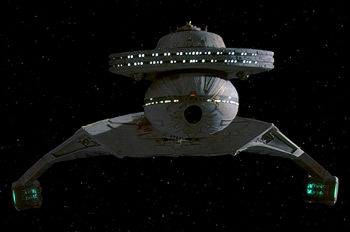
K’t’inga class (ST-06)
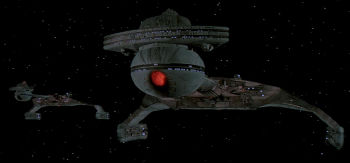
K’t’inga class (ST-01)
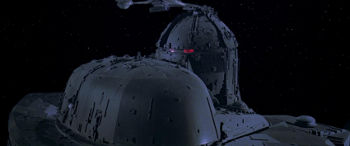
K’t’inga class command pod (ST-01)
The K’t’inga class,[2] which meant “bringer of destruction,” was introduced in mid-2269 and was a match for the Federation Constitution class and Romulan S’ten Vastam (V-6) class cruisers. This gave the Klingon Defense Force a slight advantage along its borders, and the Klingon Empire began to press the balance more aggressively. Both the Romulan Navy and Starfleet commissioned upgraded versions of their vessels shortly after the appearance of the K’t’inga class in order to hold the Klingons in check. Within two years after its introduction, 75% of all facilities producing the D-7 had been converted to manufacture the K’t’inga, allowing the Klingons to place more and more of these ships in sensitive areas.[3]
› Continue reading
Excelsior class
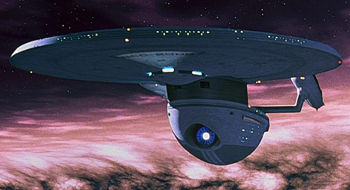
Excelsior class (ST-06)
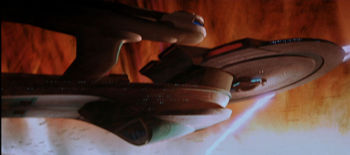
Excelsior class refit (ST-07)
In October 2284, the U.S.S. Excelsior NX-2000, the first of a new class, was commissioned. This vessel was the newest in Starfleet, and it incorporated many experimental operating systems.[3] Originally designed as a test-bed for the experimental transwarp drive, the Excelsior was called “The Great Experiment” by many in influential circles.[1] These ships were the newest of any in Starfleet and incorporated experimental technology in most of the components required to operate a starship. With so many new systems aboard these vessels, the process of testing them was slow. Prior to being installed, each component was tested and retested until it met standards. Nevertheless, when the Excelsior was taken out for trials, the evaluation teams were constantly faced with primary system malfunctions that would not allow any of the secondary or backup systems to be tested. This caused the evaluators to deal with these new components on a one-at-a-time basis, and thus creating time delays in the commissioning of the class.[3]
The Excelsior class underwent a number of late design changes when the transwarp project ultimately failed. While transwarp was never realized, designers were unwilling to cast aside what was otherwise a sound cruiser design. The transwarp engines were removed in favor of conventional linear warp drive engines. The Excelsior class could cruise at Warp 8, sustain speeds of Warp 10 for several hours, and reach Warp 13 when necessary. This made it by far the fastest Starfleet vessel for almost five decades.[31]
› Continue reading
U.S.S. Defiant NCC-1764
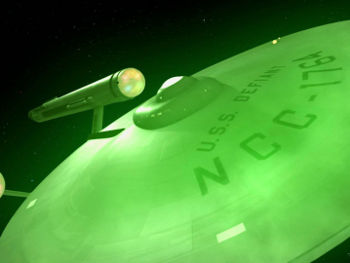
U.S.S. Defiant (TOS-64)

U.S.S. Defiant (ENT-94)
Construction began on the Constitution-class Starship Defiant at Tranquility Base, Luna,[7] in the 2250s. During the early years of her service, the Defiant conducted many missions of importance for Starfleet, and constantly patrolled the Klingon Neutral Zone as tensions between the two powers continued to rise. During that time, the Defiant became the sixth Federation starship to encounter the N’shaii, and was easily able to dispatch them.[3]
› Continue reading
Vulcan
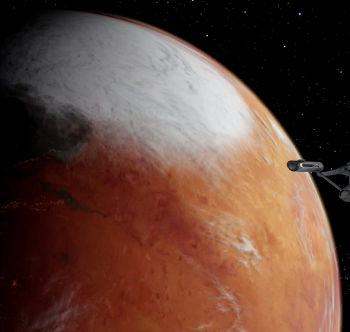
Vulcan (TOS-34)
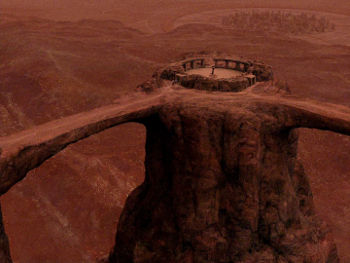
Vulcan surface (TOS-34)
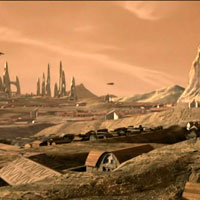
Vulcan surface (ENT-79)
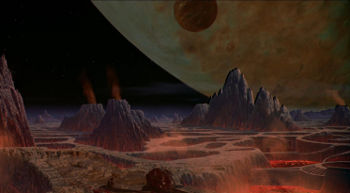
Vulcan Surface (ST-01)

Vulcan Surface (ST-01)
Vulcan, a Class-M world,[2, 4] was the second planet in the 40 Eridani trinary system, orbiting 40 Eridani A.[4] Although Vulcan had no moon,[1] the planet shared an orbit with its sister world, T’Khut.[3]
› Continue reading
Sol System
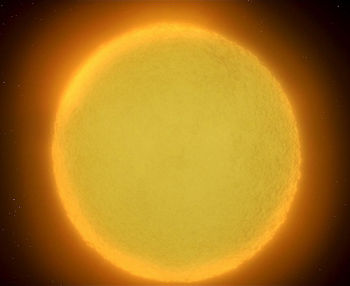
Sol (ST-04)
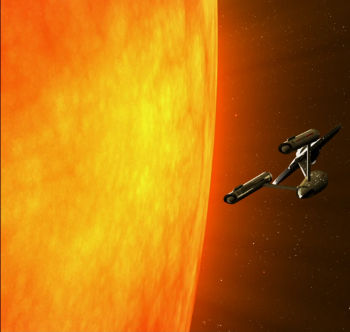
Sol (TOS-21)
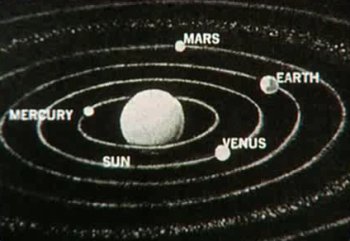
Sol System (TOS-00)
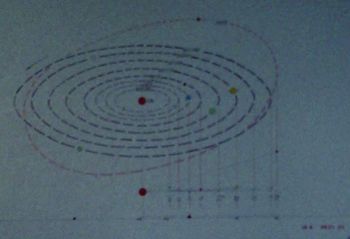
Sol System (TOS-37)
Star system located in Sector 001, in the Alpha Quadrant. The parent star, Sol, was Type-G and was orbited by eight planets (though Pluto frequently switched between being considered a planet and a planetoid),[2] including Earth, and was commonly known as the Sun. The Talosians viewed an image of the Sol System and many images of Earth’s history while accessing the U.S.S. Enterprise NCC-1701‘s computer in 2254.[1]
Planets
References
- 1. “The Cage.” Star Trek, Episode 0. Television. 1965 (Unaired).
- 2. “Before Dishonor.” Star Trek: The Next Generation. Novel (Unnumbered). November 2007.
San Francisco Fleet Yards
Shipbuilding facility orbiting the planet Earth, with offices on the surface in San Francisco, California. Several ships were built there, including:
- Enterprise NX-01[6]
- U.S.S. Enterprise NCC-1701[1]
- U.S.S. Enterprise NCC-1701-A[3]
- U.S.S. Enterprise NCC-1701-E[5]
- U.S.S. Excelsior NCC-2000[2]
- U.S.S. Sutherland NCC-72015[4]
References
- 1. “The Cage.” Star Trek, Episode 00. Television. 1965 (Unaired).
- 2. Star Trek III: The Search for Spock. Film. 1 June 1984.
- 3. Star Trek IV: The Voyage Home. Film. 26 November 1986.
- 3. “Redemption, Part II.” Star Trek: The Next Generation, Episode 201. Television. 23 September 1991.
- 5. Star Trek: First Contact. Film. 22 November 1996.
- 6. “Broken Bow.” Star Trek: Enterprise, Episodes 01-02. Television. 26 September 2001.
Milky Way Galaxy

Milky Way (TOS-01)
The Milky Way was a spiral galaxy approximately 100 thousand light years across, divided into four quadrants, designated by the Greek letters Alpha, Beta, Gamma, and Delta, and were arbitrarily divided using Earth as a reference point. As a result, Earth, and the Sol Sector, fell in the Alpha Quadrant, while the Vulcan and Andorian Sectors fell in the Beta Quadrant. The Gamma and Delta Quadrants remained largely unexplored by the early 25th century, though knowledge of those regions was greatly increased thanks to the Bajoran wormhole and the U.S.S. Voyager NCC-74656, respectively.[3] The galaxy was surrounded by a nearly-impenetrable energy field, dubbed the Galactic Barrier, with unpredictable neurogenic properties.[1, 3] Likewise, the core of the galaxy is surrounded by a distinct but related field, dubbed the Great Barrier.[2, 3]
› Continue reading
Asteroid

Asteroid (TOS-58)
Small celestial body composed of rock and metal, typically much smaller than a planet, often irregularly shaped. Asteroids often occurred in orbital belts within a star system, sometimes the debris remaining from the formation of that system, other times the fragments remaining from the disintegration of a planet. Larger asteroids were sometimes called planetoids.
In 2267, the U.S.S. Enterprise NCC-1701 attempted to divert an asteroid that was on a collision course with an inhabited planet.[1] A Type-C asteroid crashed into an unpopulated continent of Penthara IV in 2367, threatening an ecological disaster until the U.S.S. Enterprise NCC-170-D helped dispel its dust cloud.[2] Another asteroid from the Pelloris Field threatened Tessen III with the same type of destruction in 2368 before it was vaporized by the same starship. Its nitrium alloy core prevented a tractor beam lock, and it was undamaged when hit by photon torpedoes. It was later discovered to be the home of metal parasites.[3]
› Continue reading
Categories
- Animated Series (60)
- Articles (28)
- Books (447)
- Cast & Crew (79)
- Comics (22)
- DS9 (328)
- Early Voyages (125)
- Education (5)
- Enterprise (373)
- Excelsior (36)
- Food (19)
- Games (223)
- Klingon (70)
- Library (1,543)
- Logs (593)
- Lost Era (55)
- Medicine (18)
- Merrimac (1)
- Mirror (35)
- Miscellaneous (13)
- New Frontier (54)
- Next Generation (635)
- Original Series (681)
- Personnel (436)
- Places (369)
- Politics (12)
- Recreation (10)
- SCE (41)
- Science (1)
- Shatnerverse (9)
- Ships (455)
- Site Updates (98)
- Starfleet Academy (86)
- Stargazer (42)
- STO (61)
- Technology (45)
- Titan (59)
- To Boldly Go (1)
- TV/Film (214)
- Uncategorized (4)
- Vanguard (76)
- Voyager (236)
- Weapons (27)
- Xenology (54)